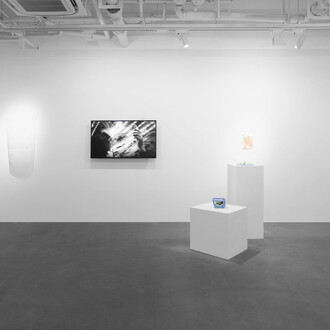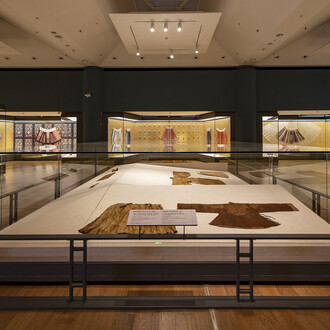Galerie Dumonteil Shanghai is very pleased to present Pollen, the solo exhibition of the gallery’s newly represented artist Ugo Schildge (b.1987), marking this emerging European artist’s debut in Asia. Featuring Schildge’s most recent works created during his two-month residency in Shanghai, Pollen encourages us to give a second look at the process of pollination — one crucial link in the entire ecosystem, and further examines human’s close rapport with nature through the artist’s allegoric narratives.
Initiated from the research on the articulation between image and movement, the artist has grown a key interest on cogwheel — a strong Industrial Revolution symbol highlighting the power of mechanics. While exploring the mechanism of cogwheels to reinvent the source of the image, and their potential as the subject of an image, the artist has developed his unique language on wood panel.
Recently, Schildge re-engages himself in focused themes and figurative representations, setting the shapes and lines in cogwheels free to dig into new possibilities in nature and humanity. In Pollen, the artist assumes a parallel world devoid of natural resources resulting in human’s struggle with food crop productions, a scenario that allows us to rediscover the importance of bees (and other pollinators) and pollination. Each work here is a captivating chapter of a grand symphony of life in which the bees, the flowers, human beings and everything that developed alongside humans are all an interconnected series of events.
Both visually and conceptually rich, the subjects of each work are also extensively exploited in the exhibition. In Brothers with Bees, the brothers are children, still asexual and chaste, just like the bees that have long been regarded as a symbol of resurrection and wisdom, while the dog stands for fidelity and support. In Lotus, the fact that the lotus is at the same time flower and fruit embodies the simultaneity of the cause and the effect within the existence. Nevertheless, the most important metaphor lies in the exhibition title — pollen embodies the spread of life and the continuity of species, as well as the irresistible and uncontrollable sexual desire.
The material is also a central element in Schildge’s work, among which honeycomb cardboard has been tactically integrated into the visual expression, rendering the work with a unique color palette and sense of layering. Working mainly with natural pigments, clay, wood and plaster, Schildge questions the traditional form of a work, blurring the border between painting and sculpture, canvas and media, control and freedom. Painterly-ness — the qualities of color, stroke, and texture — is achieved through the characteristics of each medium and their interaction with each other. The interaction is always uncertain and surprising, far from being an obstacle, the artist grasps it, to put the matter to the test of equilibrium.
Much more than a wake-up call for human development, Pollen puts the pollinators (and other overlooked crucial elements of our environment) into perspective, and highlights the true relationship between man and nature, but most of all, it invites the viewers into Schildge’s allegorical fantasy and completes it with their own imagination.
















